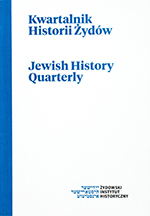Abraham bar Jacob and His Copperplate Engravings in 17th and 18th Century Amsterdam Prints
Abraham bar Jacob and His Copperplate Engravings in 17th and 18th Century Amsterdam Prints
Author(s): Magdalena BendowskaSubject(s): History, Jewish Thought and Philosophy, History of Judaism
Published by: Żydowski Instytut Historyczny
Keywords: Abraham bar Jacob; Amsterdam Haggadah; old Hebrew and Yiddish prints; Jewish printers; Amsterdam; 17th century
Summary/Abstract: In 1695, the printing shop of Asher Anshel ben Eliezer Kutner and Issachar Ber ben Eliezer of Minden issued a new edition of the Passover Haggadah, for the first time illustrated with copperplate engravings. The name of the engraver, Abraham bar Jacob, was present both on the title page and on the foldable Palestine map with a legend in Hebrew attached to the book. This book drew its inspiration from Christian sources. The artist already had collaborated earlier with Amsterdam printing offices. He produced the frontispiece of the Yiddish Bible published by Uri Phoebus (1679) and later copied in successive books printed by Uri Phoebus in Amsterdam, by Johannes Wust in Frankfort on the Main and by Shabbatai Bass in Dyhernfurth. Another frontispiece by Abraham bar Jacob was inserted by Immanuel Athias in the books Shnei Luhot ha-berit (1698) and Yad Yosef (1700), also by Shlomo Proops in Eshlei ravrevei (1711) and Maginei eretz (1732). Later, this template was used by printers Hertz Levi Rofe and his son-in-law Kosman. Both Haggadah title pages were copied by other printing offices. At first, the inclusion of Abraham bar Jacob’s illustrations in Jewish books and the author’s name did not provoke any reaction. However, as time passed by, the authorship was increasingly concealed. Athias obliterated the artist’s signature on the copperplate used in Yad Yosef, and Proops removed Abraham bar Jacob’s name from the title page of the second edition of the Haggadah. The reason for this probably was that the engraver was a convert, a pastor originating from the Rhine region who converted to Judaism in Amsterdam. This fact was mentioned for the first time by the Christian Hebraist Johann Christoph Wolf in the Bibliotheca Hebraea bibliography. Notwithstanding the artist’s origins, his illustration achieved popularity and gained numerous followers.
Journal: Kwartalnik Historii Żydów
- Issue Year: 261/2017
- Issue No: 01
- Page Range: 9-28
- Page Count: 20
- Language: English

